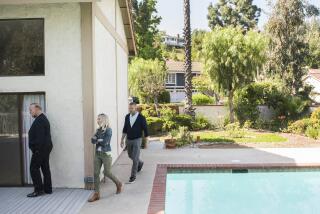Southland housing market warms up in June
- Share via
First-time buyers and investors looking for deals helped the Southland’s housing market gain ground from May to June as it struggles to overcome the effects of stubborn joblessness and a large share of borrowers who owe more than their homes than they’re worth.
Sales rose 11.6% last month from May, nearly twice what is typical for a June, with a total of 20,532 newly built and previously owned homes changing hands, according to San Diego research firm DataQuick. Housing has fought to recover from the expiration of popular tax credits for buyers last year, which temporarily boosted the market out of the worst downturn since the Great Depression.
Although declining home prices and low mortgage rates have made homes much more affordable than during the boom years, potential buyers are still worried that buying a home is a poor short-term investment, said John J. Blank, deputy chief economist for the Los Angeles County Economic Development Corp. Many people who are in a position to buy are waiting out the market, he said.
“The stadium is filled with people watching this game, and nobody wants to play,” he said. “There are always buyers, sellers and people in the stands, and right now it is filling up with more and more spectators.”
While June is typically one of the strongest months for home sales, last month’s tally nevertheless represented a 14% decline from June 2010, the last month that buyers could qualify for the popular federal tax credit that had been driving sales. After that government stimulus ended, Southland sales plunged and have remained weak.
The median sales price for the region followed a similar pattern. The median, the point at which half the homes sold for more and half for less, was $285,000 last month, a 1.8% increase from May, although it was still down 5% from June 2010.
The closely watched measure, which can vary depending on the type and location of homes that are sold, was 15.4% above the most recent bottom of $247,000, hit in April 2009 during the throes of the financial crisis. A separate measure, the Standard & Poor’s Case-Shiller index, also showed that home prices in Los Angeles and Orange counties remain above their recession-era lows.
“The housing market remains dysfunctional and lopsided, just somewhat less so than it was a few months or a year ago,” DataQuick President John Walsh said. “The market mix indicates that a lot of potential buyers are either stuck, for lack of equity, or spooked and are waiting things out.”
Typically a rising housing market helps propel the economy out of a recession. But this time, the high unemployment rate and large numbers of borrowers “underwater,” or owing more on their homes than what they could get for selling them, is holding back the market.
Los Angeles County led the state in job losses in May, shedding a net 11,400 jobs, while the county’s unemployment rate stood at 11.9% in May, the most recent numbers released. And 23.8% of all properties in the L.A. metro area with a mortgage, or 365,128, were in negative equity at the end of the first quarter, according to Santa Ana research firm CoreLogic.
Sales of so-called distressed properties — those whose owners are in some state of default — made up more than half of the Southland resales last month, DataQuick said. Roughly 1 in 3 homes resold was a foreclosure, while almost 1 in 5 was a short sale, in which the mortgage holder accepts a sale price that is less than the outstanding debt on the property.
Sales of foreclosed homes — properties foreclosed on in the previous 12 months — accounted for 33% of resales last month, down from 33.2% in May, but up from 32.8% in June 2010.
The number of foreclosure filings has dropped in recent months in the region and statewide, as well as nationally. Analysts attribute the declines to major banks slowing down the process as they try to negotiate a settlement with state and federal regulators over foreclosure practices.
Short sales in June , made up an estimated 17.7% of the market last month, the same as in May but down from 20.5% in June 2010.
Kathryn Davis, a real estate agent in Corona, said that short sales were becoming more streamlined, and many homeowners, now facing long stretches of unemployment, were becoming increasingly willing to cut their losses and submit themselves to such sales.
“They don’t qualify for a modification — and a modification is a joke anyway,” she said. “The homeowners who are short-selling are becoming a little easier to work with, whereas before they were so bitter it was tough to get the bank-required documents in time from them. Now that we are almost three or four years into it, people are aware, so it’s not like pulling teeth.”
New home sales continue to struggle, with only 1,395 transactions throughout the region last month, a 36% drop from June 2010 and the lowest new-home total for a June since DataQuick began tracking sales in 1988.
Michael Novak-Smith, a real estate agent specializing in selling foreclosed homes in the Inland Empire, said that prices were also being dragged down by a lack of buyers as well as tougher financing criteria. These days a home has to be in good shape in order for a bank to make a loan, and many credit-worthy buyers can’t get financing.
“It is very difficult to get a loan,” he said. “There is no end in sight to how bad it is and how long it is going to take to get out of this. It seems like it could be years.”
More to Read
Inside the business of entertainment
The Wide Shot brings you news, analysis and insights on everything from streaming wars to production — and what it all means for the future.
You may occasionally receive promotional content from the Los Angeles Times.









